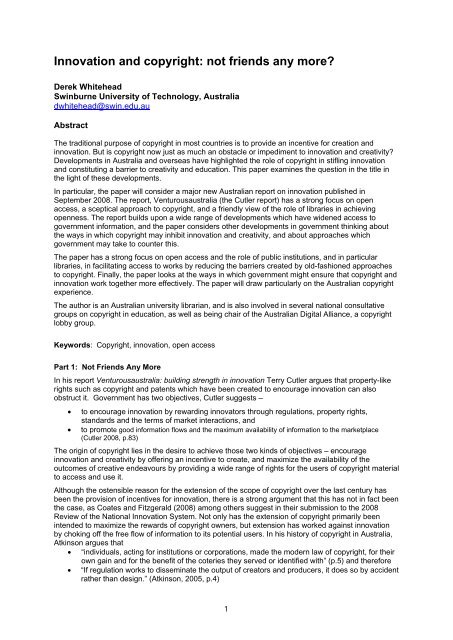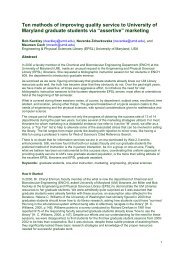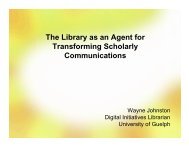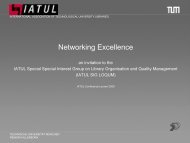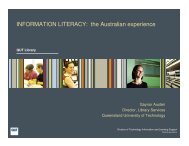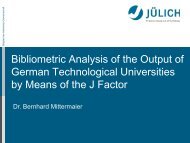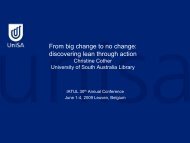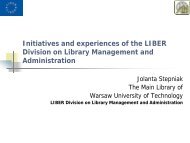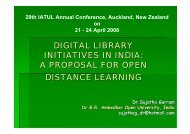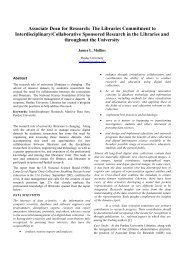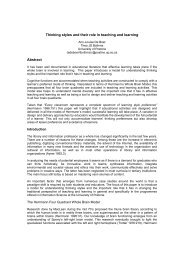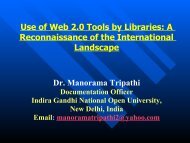Derek Whitehead - IATUL
Derek Whitehead - IATUL
Derek Whitehead - IATUL
Create successful ePaper yourself
Turn your PDF publications into a flip-book with our unique Google optimized e-Paper software.
Innovation and copyright: not friends any more?<br />
<strong>Derek</strong> <strong>Whitehead</strong><br />
Swinburne University of Technology, Australia<br />
dwhitehead@swin.edu.au<br />
Abstract<br />
The traditional purpose of copyright in most countries is to provide an incentive for creation and<br />
innovation. But is copyright now just as much an obstacle or impediment to innovation and creativity?<br />
Developments in Australia and overseas have highlighted the role of copyright in stifling innovation<br />
and constituting a barrier to creativity and education. This paper examines the question in the title in<br />
the light of these developments.<br />
In particular, the paper will consider a major new Australian report on innovation published in<br />
September 2008. The report, Venturousaustralia (the Cutler report) has a strong focus on open<br />
access, a sceptical approach to copyright, and a friendly view of the role of libraries in achieving<br />
openness. The report builds upon a wide range of developments which have widened access to<br />
government information, and the paper considers other developments in government thinking about<br />
the ways in which copyright may inhibit innovation and creativity, and about approaches which<br />
government may take to counter this.<br />
The paper has a strong focus on open access and the role of public institutions, and in particular<br />
libraries, in facilitating access to works by reducing the barriers created by old-fashioned approaches<br />
to copyright. Finally, the paper looks at the ways in which government might ensure that copyright and<br />
innovation work together more effectively. The paper will draw particularly on the Australian copyright<br />
experience.<br />
The author is an Australian university librarian, and is also involved in several national consultative<br />
groups on copyright in education, as well as being chair of the Australian Digital Alliance, a copyright<br />
lobby group.<br />
Keywords: Copyright, innovation, open access<br />
Part 1: Not Friends Any More<br />
In his report Venturousaustralia: building strength in innovation Terry Cutler argues that property-like<br />
rights such as copyright and patents which have been created to encourage innovation can also<br />
obstruct it. Government has two objectives, Cutler suggests –<br />
• to encourage innovation by rewarding innovators through regulations, property rights,<br />
standards and the terms of market interactions, and<br />
• to promote good information flows and the maximum availability of information to the marketplace<br />
(Cutler 2008, p.83)<br />
The origin of copyright lies in the desire to achieve those two kinds of objectives – encourage<br />
innovation and creativity by offering an incentive to create, and maximize the availability of the<br />
outcomes of creative endeavours by providing a wide range of rights for the users of copyright material<br />
to access and use it.<br />
Although the ostensible reason for the extension of the scope of copyright over the last century has<br />
been the provision of incentives for innovation, there is a strong argument that this has not in fact been<br />
the case, as Coates and Fitzgerald (2008) among others suggest in their submission to the 2008<br />
Review of the National Innovation System. Not only has the extension of copyright primarily been<br />
intended to maximize the rewards of copyright owners, but extension has worked against innovation<br />
by choking off the free flow of information to its potential users. In his history of copyright in Australia,<br />
Atkinson argues that<br />
• “individuals, acting for institutions or corporations, made the modern law of copyright, for their<br />
own gain and for the benefit of the coteries they served or identified with” (p.5) and therefore<br />
• “If regulation works to disseminate the output of creators and producers, it does so by accident<br />
rather than design.” (Atkinson, 2005, p.4)<br />
1
Contemporary copyright has failed to recognize that innovation and creativity build on the work of<br />
others, and in a knowledge-based or creative economy, innovation is often driven by the “second<br />
mover” principle – new ideas come from existing ideas – and tight controls over intellectual property<br />
may thwart innovation (Flew 2005).<br />
At the same time, the digital revolution has changed the landscape for copyright in a way which would<br />
once have been unimaginable. A wide range of activities has moved from being unregulated to<br />
becoming regulated by law. With a printed book, it is possible to read it, lend it to a friend, quote from<br />
it, put a copy in a library for everyone to use without direct charge. But with a digital publication, most<br />
of those activities involve making a copy, and they are therefore brought into the realm of copyright.<br />
Fitzgerald has pointed out that Web 2.0 social networks which have arisen during the last decade<br />
have created (or reinforced) parallel worlds – one social and sharing, the other commercial (Fitzgerald<br />
2008). It has also given rise to new forms of copyright, and in particular to standardized open licences<br />
– the most common being Creative Commons – by which most commonly the rights of the owner of<br />
copyright are given away, with the exception of two – the right to recognition and the right to make<br />
money from the copyright.<br />
Copyright legislation in individual countries has steadily converged as a result of adherence to the<br />
central role of the World Intellectual Property Organisation (WIPO) and the Berne Convention. This<br />
has facilitated the dominance of copyright by the large corporations which own much of the world’s<br />
valuable intellectual property – publishers, music companies, movie corporations – and has also<br />
tended to bring about increasing uniformity. The incorporation of copyright in international trade<br />
agreements has reinforced this trend.<br />
So let us take this for granted – copyright and innovation are no longer the friends they once were, and<br />
the role of copyright has extended way beyond what is required to support innovation and creativity, so<br />
much so that it often tends to stifle innovation. The move of most of the world’s information into digital<br />
form has reinforced this imbalance.<br />
What can be done to restore the balance? This paper focuses on government policy and practice in<br />
Australia, and the developments which preceded Cutler Report published in September 2008.<br />
Part 2: Australia’s Cutler Report<br />
This paper does not deal with the whole area of copyright and innovation, but takes the Australian<br />
Cutler Report, Venturousaustralia: building strength in innovation (Cutler 2008) and examines some of<br />
the approaches to making copyright better serve innovation, and the potential role of government<br />
policy in better aligning copyright with strategies to foster creativity and innovation.<br />
The Cutler Report has many antecedents, and it is a theme of this paper that governments have been<br />
moving in the direction of open content and open access for some time. Cutler himself (Cutler 2005)<br />
argued strongly several years ago that there was a major failure in public intellectual property policy<br />
which needed to be addressed.<br />
When the current Australian Government came to office in November 2007, it came with plans to<br />
review the approach of government to innovation, the Review of the National Innovation System. It<br />
commissioned Dr Terry Cutler, a consultant working in the cultural and information technology<br />
industries, to review the role of government in fostering innovation. The Cutler Report was released<br />
by the Commonwealth Department of Innovation, Industry, Science and Research (DIISR) in<br />
September 2008.<br />
The report outlines the importance of the information economy and includes a focus on the increasing<br />
importance of intellectual property. It notes in Chapter 7 (information and market design) that the<br />
development of IP is “cumulative” and “new knowledge can only be built on old knowledge”.<br />
The Cutler Report has a specific focus on information generated or held by government, and makes<br />
few recommendations which bear on non-government intellectual property. But the overall approach is<br />
a radical one, as can be seen by the recommendation on the location in government of responsibility<br />
for IP policy.<br />
In broad terms, the report made recommendations in six main areas.<br />
Intellectual Property Policy<br />
“IP policy is economic policy”, Cutler suggests (Cutler, 2008, p.86), and the report links it to<br />
competition policy, or trade practices policy, Copyright needs to move from being a specialist area of<br />
law to “an important front of micro-economic reform.” (p.85) Cutler therefore recommends that this<br />
2
area of policy be moved from a law portfolio (currently the Attorney-General’s Department) to an<br />
economic portfolio (unspecified).<br />
National Information Strategy<br />
Cutler proposed a National Information Strategy in broad terms. The basic role of such a policy is that<br />
it “optimizes the generation and flow of ideas and information in the Australian economy.” (p.94) In<br />
particular the policy should seek ways to “maximise the flow of government generated information,<br />
research, and content for the benefit of users (including private sector resellers of information).”<br />
Users, suggests Cutler, need to be able to search and interact with data and content, and there must<br />
be legal frameworks which facilitate this and make it possible.<br />
Cutler’s comparison is with National Competition Policy (NCP) – the role of a National Information<br />
Policy (NIP) is explicitly parallel and complementary. In discussion at the Open Access and Research<br />
Conference held on 24-25 September 2008 Dr Cutler suggested that a new agency should be<br />
established to drive the information policy agenda (Cutler 2008-oar).<br />
Government research, information and content<br />
The report proposes making available government information of all kinds as widely as possible to<br />
both commercial and non-commercial entitles. This includes information such as research funded by<br />
government, and information collected and held by government. The report uses the term “research,<br />
information and content” to describe in shorthand what information was intended – very broad terms.<br />
The argument is clear: the purpose of the proposal was to maximize the economic and social benefits<br />
arising from open access to government information. It was further argued that we are headed that<br />
way, and for good reasons. Cutler cited (p.93) econometric research by John Houghton (Houghton,<br />
Steele & Sheehan, 2006), and the trend to open access mandates throughout the world, albeit patchily<br />
in Australia.<br />
Cutler addressed the state of open access to government material, and referred to spatial data as the<br />
leader in public access to public sector materials. The next section of this paper deals with some<br />
Australian developments, several of which Cutler alludes to. The clear conclusion – “Australia is<br />
behind many other advanced countries in establishing institutional frameworks to maximize the flow of<br />
government generated information and content.” (Cutler, 2008, p.94)<br />
Forms of licence<br />
Cutler did not dwell on the mechanisms by which government makes available its information.<br />
However, Recommendation 7.8 did refer to use of “a creative commons licence”, which was referred<br />
to in terms of “international standards of open publishing.” The Cutler Report itself has an Attribution-<br />
Non-commercial-No Derivative Works 2.5 Australia Creative Commons license, and increasing<br />
amounts of government information, are made available through Australian Creative Commons (CCA)<br />
licences (Creative Commons Australia 2009).<br />
National collections<br />
Cutler has a strong focus on what he described as “national collections”. Within this category he<br />
included repositories within universities and research institutes, as well as the cultural collections of<br />
libraries, museums, archives and art museums. He quoted the Australian physicist Michael Nielsen<br />
“Information not on the network can’t do any good” in his call for an open scientific culture (Nielsen,<br />
2009)<br />
Nielsen’s call, reflected in the Cutler report (Cutler, 2008, p.96), is a radical one. He argued for open<br />
licensing, “creative re-use and modification”, and a range of new services and applications which<br />
amount to a kind of “extreme openness”. Cutler added to this the importance of national collections of<br />
all kinds – cultural, geological, historical, zoological.<br />
The section of the report dealing with national collections included recommendations for a series of<br />
actions – enhanced funding for cultural and scientific collections, specific funding for open access<br />
repositories, support for key state collections as well as national collections, access to contestable<br />
research funding programs for cultural and collecting agencies, and enhanced preservation of<br />
indigenous collections,<br />
The Global public commons<br />
As Cutler points out, what was once national commons is now global. Therefore “Australia should<br />
energetically and proudly maximize the extent to which it makes government funded content available<br />
3
as part of the global digital commons.” (Cutler 2008, p.98) And Australia must encourage others to do<br />
the same. There is a clear focus in the report on global availability of Australian copyright material.<br />
Outcomes of the Cutler Report<br />
The Cutler Report sets a significant agenda – to reconcile copyright and innovation, at least to the<br />
extent that government policy can contribute to this. At the time of writing the Government was still<br />
developing a white paper in response. However, the Minister for Innovation, Industry, Science and<br />
Research, Senator Kim Carr, commented favourably on the Cutler Report soon after its appearance,<br />
and in particular said<br />
“These are all recommendations dear to my heart.<br />
It is my firm view that publicly funded research should be widely available to other researchers,<br />
industry and the general public.<br />
That doesn’t just mean letting people search for keywords or abstracts.<br />
It means full, open access to research data and outputs.<br />
If we are serious about boosting innovation, we have to get knowledge and information flowing<br />
freely.”<br />
The Minister also suggested<br />
”The overzealous protection of intellectual property rights in this environment raises the cost of<br />
knowledge to the community. When that knowledge is created using tax-payer dollars, the<br />
community might reasonably feel that it has paid for it once already.” (Carr 2008)<br />
This position, albeit deeply felt by the Minister, still needs to be argued in and be adopted by<br />
government. In the meantime, Dr Cutler continues to speak and write about innovation.<br />
Part 3: Open access to research<br />
Within the area of research, government policy and initiatives have since 2004 prefigured the work of<br />
the Cutler review of innovation. This has been documented extensively. For example, very recently<br />
Kennan and Kingsley (2009) conducted and reported on a survey of Australian institutional repository,<br />
and outlined the course of government support over the previous five years. In fact, support from the<br />
Australian Government for open access repositories goes back to the initial funding in 1997 of the<br />
Australian Digital Theses program; this is now fully mainstreamed in almost all universities, and has<br />
become Australasian (CAUL 2008).<br />
The Accessibility Framework<br />
Within the area of research, the Commonwealth Government and its predecessor have supported an<br />
Accessibility Framework which is defined as “the collective efforts by institutions, organisations and<br />
individuals to managing (sic) research outputs and infrastructure, including information infrastructure,<br />
so that they are discoverable, accessible and shareable, in order to improve the quality of research<br />
outcomes, reduce duplication and better manage research activities and reporting.” (DEEWR, 2004)<br />
In another place, Terry Cutler (Cutler 2007) summed up the case for wide diffusion of the results of<br />
research:<br />
“The more rapid the technology diffusion, the more rapid the take-up, the greater the externalities<br />
that arise from the wide-ranging penetration of new ideas and know-how. But that notion of<br />
realising the community benefits of the externalities is completely at odds with the notion of<br />
expropriating public sector funded knowledge into the micro-economic level of the firm and startups<br />
and so forth.”<br />
The ASHER program<br />
In support of this framework, the Commonwealth has provided, over the period 2007-2009, funding to<br />
universities to establish and populate repositories of research outputs, with the content to be available<br />
on open access to the extent possible. In most cases this funding has gone to the library, which is<br />
usually responsible for managing the university open access repository of research outputs. In addition<br />
to the A$25.5 million allocated to creation of repositories through ASHER, the Commonwealth has<br />
funded a number of projects which have contributed to the development of repositories in Australian<br />
universities. (DIISR 2009)<br />
Dr Alex Cooke, in a recent presentation, set out the current Australian Government open access<br />
agenda, at least in the area of research outputs. He suggested that the Accessibility Framework set<br />
out in 2004 applies not only to research publications but also to research data and other outputs. “The<br />
4
provision of open access should include the curation and preservation of digital material including<br />
cataloguing, archiving, reproducing, safekeeping and media migration of research outputs”, says<br />
Cooke (Cooke 2008)<br />
Research funding<br />
Moreover, the funding rules of Australia’s major research funding bodies, the Australian Research<br />
Council (ARC) and the National Health and Medical Research Council (NHMRC) have been moving<br />
towards requiring deposit of publications arising from research grants in an open access repository –<br />
although this is only encouraged at present. The current statement (ARC 2008) at A1.3.3 is:<br />
“The ARC therefore encourages researchers to consider the benefits of depositing their data and<br />
any publications arising from a research project in an appropriate subject and/or institutional<br />
repository. If a researcher is not intending to deposit the data from a project in a repository within<br />
six months of completion of the research, he/she should include the reasons in the project’s Final<br />
Report. . . .”<br />
The Code for the Responsible Conduct of Research (NHMRC 2007) also has a strong focus on the<br />
obligation to make research findings public.<br />
Legal framework<br />
The Government has funded a major project – the Open Access to Knowledge Law (OAK Law) Project<br />
– which has worked to provide a legal framework for open access through a series of research reports<br />
and other publications. These provide an invaluable basis for the further development of practical<br />
toolkits and guides to copyright issues for researchers, and all are made available using Creative<br />
Commons licences, available for download from the OAK Law site. (OAK Law 2009) In particular,<br />
reports and guides on copyright and open access, and for research students, institutional repositories,<br />
authors, and others.<br />
Part 4: The Digital Education Revolution and other approaches by government<br />
The move to make government and government-controlled content much more open is now welladvanced<br />
in Australia. Coates and Fitzgerald (2008) use examples from many countries to show this<br />
trend, and to demonstrate recognition of “the economic advantages of enabling reuse of government<br />
information through open content licensing”.<br />
In several fields, government has already moved ahead, as Cutler pointed out. Greenleaf (Greenleaf<br />
2008, pp.80-82) canvasses the issue, as did a report on innovation by the Productivity Commission<br />
(2007) among others. Openness of government information is also increasingly coming under scrutiny<br />
in the general popular press – recent examples include the denial of government data on the location<br />
of toilets to a software developer who wished to make the information accessible on an iphone (Gans<br />
2008) and lack of access through Google maps to bushfire location information (Braue 2009)<br />
In other fields, the government has made little progress. The (now abolished) Copyright Law Review<br />
Committee reported on the issue of Crown Copyright in 2005, and its report was released in April<br />
2005. However, there has (four years later) been no response from government.<br />
In Australia the move to more open access is limited by the fact that there are eight state and territory<br />
jurisdictions in addition to the national (Commonwealth) government, so there are a lot of governments<br />
to deal with. In some cases, state governments are actively exploring options for greater accessibility<br />
of government information; Coates and Fitzgerald quote the Queensland Spatial Information Council<br />
estimate of 85% of government information suitable for release under a Creative Commons license.<br />
But over many fields, government has made significant progress, and this is illustrated below.<br />
Education<br />
The Digital Education Revolution (DER) refers to the Australian Government policies in relation to<br />
technology in education. Fairly recently. AICTEC (the Australian ICT in Education Committee, the<br />
body which coordinates education provision by the Commonwealth and the eight state and territory<br />
governments) has established an Intellectual Property and Privacy in Technology Advisory Group<br />
(IPPTAG) (AICTEC 2009). The group has a focus on several issues, including the extent to which<br />
copyright law and practical realities inhibit the use of digital content in education, and the extent to<br />
which open licences can be used to maximize availability of educational resources.<br />
Increasingly, government agencies involved in the development of curriculum materials are adopting<br />
or exploring open models for licensing. These models may focus on licensing for education, or more<br />
5
open licences, or sharing arrangements such as the National Educational Access Licence for Schools<br />
(NEALS) (Curriculum Corporation, 2008). Legislative amendments to the Copyright Act 1968 at the<br />
end of 2006 also incorporated a new exception with significant benefits to education and libraries<br />
(Simes 2008). Universities have also begun in some cases to provide open course materials – such as<br />
University of Southern Queensland’s OpenCourseWare (Cobcroft 2008, pp.183-4)<br />
Geospatial information<br />
The Cutler report refers to geospatial information as an area which is well advanced in policy<br />
development for open access. Geosciences Australia (GA) has an Australian Government Policy on<br />
Spatial Data Access and Pricing, launched in 2001. Maps and other products of Geoscience Australia<br />
are available without charge, and under a generous licence which permits the user to<br />
“a. use, reproduce, adapt, modify, commercially exploit and communicate the Data (including by<br />
development and distribution of a Deriviative Product); and<br />
b. sublicense the Licensee's right to use, reproduce, adapt, modify, commercially exploit and<br />
communicate the Data, subject to the terms of this Licence.” (Geosciences Australia 2001)<br />
Statistics<br />
In December 2005 the Australian Bureau of Statistics (ABS), the national statistical agency, made all<br />
statistics available from the ABS website free of charge. More recently, in December 2008, ABS<br />
modified the licence involved in using its statistics, and placed all material under a Creative Commons<br />
Attribution 2.5 Australia licence. There are very few exceptions – “except the ABS logo, the<br />
Commonwealth Coat of Arms, and any material protected by a trade mark.” (ABS 2009) This means<br />
that this material may be adapted and re-used, and may be used for commercial as well as noncommercial<br />
purposes.<br />
Legal information<br />
The Australian Legal Information Institute (AUSTLII) is a joint enterprise of the Faculties of Law of<br />
University of New South Wales and the University of Technology Sydney. AUSTLII makes available<br />
public legal information – “legislation, treaties and decisions of courts and tribunals); and secondary<br />
legal materials created by public bodies for purposes of public access (law reform and royal<br />
commission reports for example) and a substantial collection of law journals.” (AUSTLII, 2009)<br />
AUSTLII is a free service and is maintained by the two institutions which created it, deriving income<br />
from grants and donations. Material on the site is reproduced with the permission of copyright owners<br />
and government entities.<br />
The Australian Broadcasting Corporation<br />
The Australian Broadcasting Corporation (ABC) is a national broadcaster, providing radio, television<br />
and internet services to Australians and overseas. The ABC has the largest audiovisual archive in<br />
Australia, and has recently established a collaborative media site, Pool. This provides material<br />
available for re-use, and has recently released material into the pool using a Creative Commons<br />
Attribution-Noncommercial licence – the first use by the ABC of a CCA licence. In practice, the licence<br />
enables others to re-mix and re-use provided that it is for a non-commercial purpose (ABC, 2009)<br />
Part 5: Conclusion<br />
It is quite clear that well before the Cutler report there was much movement in government towards a<br />
range of measures which would make copyright, at least in relation to government information, more<br />
hospitable to innovation. There is a wide range of tools now emerging to make it easier for those<br />
involved in innovation and creation to re-use and build upon the work of others. These include<br />
• New licensing models – in particular open licences, and amongst those, the Creative Commons<br />
licences. These are now international, and are used in many different contexts in government and<br />
elsewhere. At the same time, other forms of open licences are also used.<br />
• New ways of handling government information for the benefit of all are being developed. Although<br />
there has always been a model for this in the case of the United States, other countries –<br />
especially Crown Copyright countries – are moving to the view that innovation and economic<br />
advance take place when government-controlled information is made freely available to those who<br />
can exploit it.<br />
• New approaches to research are being taken, which recognise government-supported research in<br />
particular as a public asset. The movement to open access to research repositories, fostered by<br />
6
and largely managed by libraries, is only one side of this – research data is also being considered<br />
in the same way as research publication.<br />
• Governments are considering new policy agendas and seeing copyright as primarily an economic<br />
policy issue, posing the question – how can we use innovation and creativity to drive the creation of<br />
wealth. They are coming to the conclusion that creation of a long-term monopoly through<br />
conventional copyright is not the best way to go.<br />
• New business models are emerging which recognize the way which information spreads in a<br />
networked digital world, and which adapts to this reality. Copyright owners do make money from<br />
their work in different ways – not just by selling copies or access. Many people earn a living from<br />
creativity and innovation – from research, information and content, and new business models aim<br />
to maximise use and value, not protection.<br />
• Changes to the law are also on the horizon. For example, changes which differentiate between<br />
commercial and non-commercial uses and permit a much wider range of access in the case of the<br />
latter are proposed. The issue of widening exceptions and user rights is also under consideration,<br />
especially in areas such as education and research. The strong legislative agenda in Australia over<br />
the last decade is not exhausted – more is likely.<br />
This paper has dealt with the strong agenda for change within Australian government. It is written<br />
before the publication of a response of the Australian Government to the Cutler report, and Australians<br />
look forward hopefully to a more systematic, dynamic, and wide-ranging approach from all Australian<br />
governments.<br />
References<br />
Access to and Use of Public Sector Information (auPSI) (2009) [website] Retrieved on 3 March 2009<br />
from http://www.aupsi.org/<br />
Atkinson, Benedict (2005), The true history of copyright: the Australian experience 1905-2005.<br />
Sydney: Sydney University Press.<br />
Australian ICT in Education Committee (AICTEC), Intellectual Property and Privacy in Technology<br />
Advisory Group (IPPTAG).[website] Retrieved 25 February 2009 from<br />
http://www.aictec.edu.au/aictec/go/home/about/cache/offonce/pid/255<br />
Australian Broadcasting Corporation (ABC) (2009). Pool. Retrieved on 26 February from<br />
http://www.pool.org.au<br />
Australian Bureau of Statistics (2009). [website] Retrieved on 26 February 2009 from<br />
http://www.abs.gov.au<br />
Australian Legal Information Institute (2009). [website] Retrieved on 26 February from<br />
http://www.austlii.edu.au/austlii/<br />
Australian Research Council, Discovery Projects Funding Rules for funding commencing in 2010. 1<br />
December 2008. Retrieved 26 February 2009 from http://www.arc.gov.au/pdf/DP10_FundingRules.pdf<br />
Braue, David (2009) “Vic Govt limited Google’s bushfire map” in ZDNet Australia February 12, 2009.<br />
Retrieved on 3 March from<br />
http://www.zdnet.com.au/news/communications/print.htm?TYPE=story&AT=339294916-130061791t-<br />
110000003c<br />
Carr, Senator Kim, Speech: Open Access and Research Conference, 24 September 2008. Retrieved<br />
25 February, 2008 from<br />
http://minister.innovation.gov.au/Carr/Pages/OpenAccessandResearchConference.aspx<br />
Committee of Australian University Librarians (CAUL) (2008) Australasian Digital Theses Program<br />
[website] Retrieved 2 March 2009 from http://www.caul.edu.au/adt/<br />
Coates, Jessica and Fitzgerald, Brian (2008). Copyright and innovation: freedom to innovate.<br />
Submission to the Review of the National Innovation System. Retrieved 28 February 2009 from<br />
http://www.innovation.gov.au/innovationreview/Documents/435-Jessica_Coates.pdf<br />
Cobcroft, Rachel (ed) (2009) Building an Australasian commons. Creative Commons case studies,<br />
Volume 1. Brisbane: ARC Centre of Excellence for Creative Industries and Technology and others.<br />
Available from http://creativecommons.org.au/casestudiesvol1<br />
7
Cooke, Alexander, Research infrastructure and the open access agenda. Australian Research<br />
Council, 2008. Unpublished Powerpoint MS.<br />
Copyright Law Review Committee (2005), Crown Copyright. Canberra: The Committee. Retrieved 4<br />
March 2009 from<br />
http://www.ag.gov.au/agd/WWW/clrHome.nsf/AllDocs/4F25A124B6E6F1A4CA256FDB0015D5A7?Op<br />
enDocument<br />
Creative Commons Australia (2009). Creative Commons licences. Retrieved 25 February 2009 from<br />
http://www.creativecommons.org.au/<br />
Curriculum Corporation (2008) Report on jurisdictional contribution to the national content pool pilot.<br />
Melbourne: The Learning Federation. Retrieved 3 March from<br />
http://www.tlf.edu.au/verve/_resources/Report_on_jurisdictional_contribution_to_national_pool.pdf<br />
Cutler, Terry (2005) Creative content and the failures of public IP policy. Paper delivered at the Open<br />
Content Licensing Conference, Queensland University of Technology, 18-19 January 2005. Retrieved<br />
3 March 2009 from http://www.cutlerco.com.au/activities/speeches/05_speeches/Creative_content.pdf<br />
Cutler, Terry (2007) [contributor to discussion] “Why Governments and Public Institutions Need to<br />
Understand Open Content Licensing” in Brian Fitzgerald, Jessica Coates and Scott Kiel-Chisholm,<br />
Submission to the Government inquiry on the extension of legal deposit to electronic and audiovisual<br />
materials, Intellectual Property: Knowledge, Culture and Economy, Brisbane: Queensland University of<br />
Technology.<br />
Cutler, Terry (2008). Venturousaustralia: building strength in innovation. Canberra, Department of<br />
Innovation, Industry, Science and Research. Retrieved 25 February 2009 from<br />
http://www.innovation.gov.au/innovationreview<br />
Cutler, Terry (2008-oar) [oral presentation] Open Access and Research Conference, Brisbane, 24-25<br />
September, 2008. Retrieved on 3 March 2009 from http://www.oaklaw.qut.edu.au/node/61<br />
Department of Education, Employment and Workplace Relations (DEEWR). Accessibility Framework,<br />
2004. Retrieved 25 February 2009 from<br />
http://www.dest.gov.au/sectors/research_sector/policies_issues_reviews/key_issues/accessibility_fra<br />
mework<br />
Department of Innovation, Industry, Science and Research (DIISR). Australian Scheme for Higher<br />
Education Repositories (ASHER). Retrieved 24 February 2009 from<br />
http://www.innovation.gov.au/Section/AboutDIISR/FactSheets/Pages/AustralianSchemeforHigherEduc<br />
ationRepositories(AHSER)FactSheet.aspx<br />
Fitzgerald, Brian (2008), “Copyright 2010: the future of copyright”, in European Intellectual Property<br />
Review (2008) 30: 43. Retrieved 24 February 2009 from http://eprints.qut.edu.au<br />
Flew, Terry (2005), “Creative commons and the creative industries”, in Media and Arts Law Review<br />
257: 10.<br />
Gans, Joshua (2008), “Caught short: information controls kill opportunities”, in The Age, 5 August,<br />
2008. Retrieved 2 March 2009 from http://business.theage.com.au/business/caught-short-informationcontrols-kill-opportunities-20080804-3q03.html<br />
Geosciences Australia (2001), Australian Government Policy on Spatial Data Access and Pricing.<br />
Retrieved 25 February 2009 from<br />
http://www.osdm.gov.au/OSDM/Policies+and+Guidelines/Spatial+Data+Access+and+Pricing/default.a<br />
spx<br />
Greenleaf, Graham (2008). Unlocking IP to stimulate Australian innovation: an issues paper.<br />
University of New South Wales Faculty of Law Research Series. Paper 44. Retrieved 24 February<br />
2009 from http://law.bepress.com/unswwps/flrps08/art44<br />
Houghton, John, Steele, Colin and Sheehan, Patrick (2006), Research Communication Costs in<br />
Australia: Emerging Opportunities and Benefits. Canberra: Department of Education, Science and<br />
Training (DEST) http://www.dest.gov.au/NR/rdonlyres/0ACB271F-EA7D-4FAF-B3F7-<br />
0381F441B175/13935/DEST_Research_Communications_Cost_Report_Sept2006.pdf<br />
8
Kennan, Mary Ann and Kingsley, Danny L (2009), “The state of the nation: A snapshot of Australian<br />
institutional repositories”, in First Monday, 14:2. Retrieved 2 March 2009 from<br />
http://firstmonday.org/htbin/cgiwrap/bin/ojs/index.php/fm/article/view/2282<br />
Lessig, Lawrence. Free culture: how big media uses technology and the law to lock down culture and<br />
control creativity. New York, The Penguin Press, 2004.<br />
National Health and Medical Research Council, Australian Research Council and Universities<br />
Australia (2007), Australian Code for the Responsible Conduct of Research. Retrieved 26 February<br />
2009 from http://www.nhmrc.gov.au/publications/synopses/r39syn.htm<br />
Nielsen, Michael. Blog. Retrieved 25 February 2009 from http://michaelnielsen.org/blog<br />
Open Access to Knowledge Law Project (2009). Reports, guides and publications. Retrieved 2 March<br />
2009 from http://www.oaklaw.qut.edu.au/reports<br />
Producivity Commission (2007), Public Support for Science and Innovation. Retrieved 26 February<br />
2009 from http://www.pc.gov.au/projects/study/science/docs/finalreport<br />
Simes, Laura (2008), A user’s guide to the flexible dealing provision for libraries, educational<br />
institutions and cultural institutions. Canberra: Australian Digital Alliance and the Australian Libraries<br />
Copyright Committee. Retrieved 26 February 2009 from.<br />
http://www.digital.org.au/documents/FlexibleDealingHandbookfinal.pdf<br />
9


